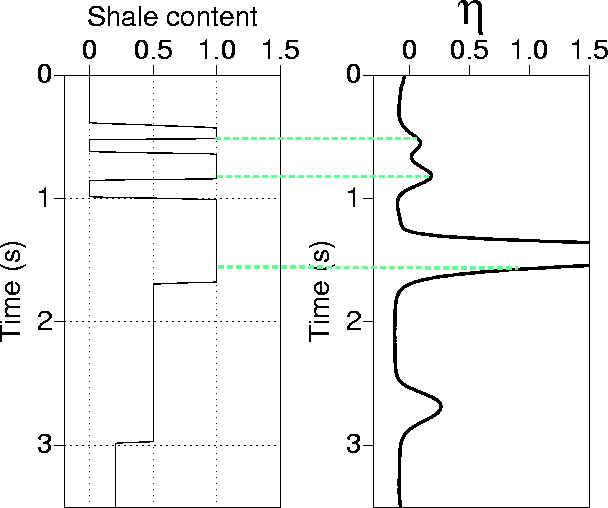




Next: Discussion and conclusion
Up: Anisotropy processing
Previous: The first line
Figure 11 shows a zero-offset section that contains
a large number of faults. Because of the large offsets present in this
data set, we will use the non-hyperbolic
method to invert for  . VTI media induce
non-hyperbolic
moveout of reflections that depends on
. VTI media induce
non-hyperbolic
moveout of reflections that depends on  and
and  at
large
offsets. This non-hyperbolic moveout is used to invert
for these two parameters, which provide important information about
the subsurface. The direct
output from such an
inversion (or velocity analysis) is effective values of
at
large
offsets. This non-hyperbolic moveout is used to invert
for these two parameters, which provide important information about
the subsurface. The direct
output from such an
inversion (or velocity analysis) is effective values of  and
and  ,
that include the combined (average) influence of the overburden. These
effective values are converted
to interval ones using layer-stripping equations given by Alkhalifah
(1997b).
,
that include the combined (average) influence of the overburden. These
effective values are converted
to interval ones using layer-stripping equations given by Alkhalifah
(1997b).
dmois
Figure 11 Stacked section of a second line from offshore Trinidad,
after applying NMO and
isotropic homogeneous DMO. The NMO correction is based on the
velocities provided by Amoco.

Figure 12 shows a detail of CMP gather 3100 with a
reflection from a horizontal event and the reflection are NMO
corrected using different stacking
velocities.
The highest amplitude stack
trace (stack power) is obtained using a velocity of 2100 m/s. Using
this velocity, however, did not
result in the best resolution of the stacked trace as indicated by the
amplitude spectrum. Better
resolution (higher-frequency content) is achieved at a lower velocity.
However, the best solution
is obtained through anisotropic processing as shown in
Figure 13, where the non-hyperbolic
moveout in the data is treated. A shift in the zero offset time
of more than 10 ms from its true value (as given by the near-offset trace)
occurs after stacking the 2100 m/s NMO-corrected data.
nmostackf
Figure 12 CMP gathers for CMP location 3100 after NMO correction with
(a)
 =2060 m/s,
(b)
=2060 m/s,
(b)  =2080 m/s, (c)
=2080 m/s, (c)  =2100 m/s, and (d)
=2100 m/s, and (d)
 =2120 m/s. The
first column to the left is the CMP gather, the center column is the
stack of the CMP gather, and
right most column shows the amplitude spectrum of the stacked gather.
=2120 m/s. The
first column to the left is the CMP gather, the center column is the
stack of the CMP gather, and
right most column shows the amplitude spectrum of the stacked gather.

Clearly, a hyperbolic moveout approximation does not adequately
approximate the
non-hyperbolic moveout represented in the data. This non-hyperbolic
moveout can not be
explained solely by vertical velocity variations. Furthermore, the
lateral inhomogeneity that is apparent in
these data by observing velocities from various CMP locations is not
sufficient to
explain such a large non-hyperbolic moveout.
nmostackfti
Figure 13 The CMP gather of Figure 12 after
non-hyperbolic correction. The
first plot to the left is the CMP gather, the center plot is the stack
of the CMP gather, and
right most plot shows the amplitude spectrum of the stacked gather.

etav
Figure 14 Estimated interval values  and
and  as a
function of vertical time.
as a
function of vertical time.

Figure 14 shows the interval velocity and  values
extracted
from the non-hyperbolic moveout inversion
for CMP location 3200. Considering that the lateral inhomogeneity is
small, we will use these
values to do VTI DMO and time migration on the whole section (time
processing). The extremely high
values
extracted
from the non-hyperbolic moveout inversion
for CMP location 3200. Considering that the lateral inhomogeneity is
small, we will use these
values to do VTI DMO and time migration on the whole section (time
processing). The extremely high  value
at time 1.5 s is indicative of a highly anisotropic shale layer. Also,
due to the integral relation between the interval values and the
effective ones, the area under
these
value
at time 1.5 s is indicative of a highly anisotropic shale layer. Also,
due to the integral relation between the interval values and the
effective ones, the area under
these  curves, representing the cumulative anisotropy,
tells a better story of the anisotropic impact on the seismic data
than the values for the individual intervals. The presence of a
thick, highly anisotropic shale at relatively shallow depths (i.e., above
zones of interest) will have a serious impact on the effective
anisotropy for all deeper layers. If this shallow anisotropy is not taken into
account in this case, then degradation of the entire stacked
section will result.
Figure 15 shows the result of anisotropic DMO and when
comparing
it with Figure 11 the improvements in focusing the
horizontal, as well
as the dipping reflections, are
obvious.
curves, representing the cumulative anisotropy,
tells a better story of the anisotropic impact on the seismic data
than the values for the individual intervals. The presence of a
thick, highly anisotropic shale at relatively shallow depths (i.e., above
zones of interest) will have a serious impact on the effective
anisotropy for all deeper layers. If this shallow anisotropy is not taken into
account in this case, then degradation of the entire stacked
section will result.
Figure 15 shows the result of anisotropic DMO and when
comparing
it with Figure 11 the improvements in focusing the
horizontal, as well
as the dipping reflections, are
obvious.
dmoti
Figure 15 Stacked section after v(z) anisotropic DMO using the
parameters in
Figure 14. The NMO correction is based on the
velocities
obtained from the conventional velocity analysis using exceptionally
short spreads.

Figure 16a shows the result of isotropic migration on the
isotropically DMO corrected data,
while Figure 16b
shows the results of a complete VTI processing, including migration. A closer look given by
Figure 17
shows the improvement in
fault imaging achieved with the VTI processing.
mig
Figure 16 Time-migrated sections after (a) isotropic processing, and
(b)
VTI processing using
the inverted parameters shown in Figure 14. A
detailed picture is shown in
Figure 17.

migc
Figure 17 Detail of Figure 16 consisting of
time-migrated sections after (a) isotropic processing, and (b) VTI
processing.

etacurvesmig2
Figure 18 Three interval  curves superimposed on the
time-migrated
section of
Figure 16b. These
curves superimposed on the
time-migrated
section of
Figure 16b. These  values correspond to the
region above each fault.
values correspond to the
region above each fault.

Figure 18 shows three  curves superimposed on
the migrated section from Figure 16b. These
curves superimposed on
the migrated section from Figure 16b. These  curves
correspond to CMP locations 3000, 3200, and 3400, and as a result they
are placed in their respective
positions in the Figure 18. Recognizing that the
curves
correspond to CMP locations 3000, 3200, and 3400, and as a result they
are placed in their respective
positions in the Figure 18. Recognizing that the  highs and lows correspond
to reflections from the bottom of the layer
that caused these highs or lows, a crude blocky interpretation of the
curves
can be made and is given in Figure 19. The lateral
correlation between these
curves that are 2.5 km of
lateral distance apart is remarkable. Especially remarkable is the
correlation between the thickness of the shale layers and the size of
highs and lows correspond
to reflections from the bottom of the layer
that caused these highs or lows, a crude blocky interpretation of the
curves
can be made and is given in Figure 19. The lateral
correlation between these
curves that are 2.5 km of
lateral distance apart is remarkable. Especially remarkable is the
correlation between the thickness of the shale layers and the size of  (look at
the first laterally continuous shale layer). The extremely high
(look at
the first laterally continuous shale layer). The extremely high  value
at time 1.5 s is indicative of a highly anisotropic shale layer. While
the actual value may appear unreasonable, CMPs 3200 and 3400 are over
a gas field, while CMP 3000 is outside of the field
(Figure 20). The high
value
at time 1.5 s is indicative of a highly anisotropic shale layer. While
the actual value may appear unreasonable, CMPs 3200 and 3400 are over
a gas field, while CMP 3000 is outside of the field
(Figure 20). The high  values over the field could
suggest vertical migration of the gas into the unconsolidated shale
(this shale is approximately 2000 feet thick at depths of 3000-5000
feet, see Figure 15).
values over the field could
suggest vertical migration of the gas into the unconsolidated shale
(this shale is approximately 2000 feet thick at depths of 3000-5000
feet, see Figure 15).
etadismig
Figure 19 The same three interval  curves shown in
Figure 18. The white curves correspond to a crude
interpretation of the
layering in the subsurface that correspond to the
curves shown in
Figure 18. The white curves correspond to a crude
interpretation of the
layering in the subsurface that correspond to the  curves.
curves.

Figure 20 shows a crude lithologic interpretation
estimated solely from the anisotropic inversion. The interpretation is
based on the fact that shales are anisotropic, and therefore exhibit large
positive  values,
while sands are essentially isotropic with near zero
values of
values,
while sands are essentially isotropic with near zero
values of  . Figure 14 shows the correlation
between the estimate for
. Figure 14 shows the correlation
between the estimate for  at CMP 3200 and a blocky
interpretation of shale volume from the gamma-ray log at a nearby
well. Correlation is remarkably good down to 2.0 seconds,
demonstrating the value of using the inversion for
at CMP 3200 and a blocky
interpretation of shale volume from the gamma-ray log at a nearby
well. Correlation is remarkably good down to 2.0 seconds,
demonstrating the value of using the inversion for  as a
lithology estimator. Correlation is not as good below 2.0 seconds,
though the
as a
lithology estimator. Correlation is not as good below 2.0 seconds,
though the  value shown in Figure 21 shows
a large decrease in velocity below 2.0 seconds indicative of entering
the overpressure zone (which could also impact anisotropy).
value shown in Figure 21 shows
a large decrease in velocity below 2.0 seconds indicative of entering
the overpressure zone (which could also impact anisotropy).
etalayermig2
Figure 20 Lithological interpretation of the sand and shale content of
the surface as estimated
by the interval  values obtained from the inversion. The white
lateral lines follow seismic reflections.
values obtained from the inversion. The white
lateral lines follow seismic reflections.

comparsh
Figure 21 Estimated interval values  plotted next to an
approximate
long wavelength of
shale content extracted from gamma-ray measurements. The gray dashed
lines correspond to bottom of
shale layer predicted by the
plotted next to an
approximate
long wavelength of
shale content extracted from gamma-ray measurements. The gray dashed
lines correspond to bottom of
shale layer predicted by the  curve and agrees well with the
gamma-ray information.
curve and agrees well with the
gamma-ray information.






Next: Discussion and conclusion
Up: Anisotropy processing
Previous: The first line
Stanford Exploration Project
11/11/1997
![]() . VTI media induce
non-hyperbolic
moveout of reflections that depends on
. VTI media induce
non-hyperbolic
moveout of reflections that depends on ![]() and
and ![]() at
large
offsets. This non-hyperbolic moveout is used to invert
for these two parameters, which provide important information about
the subsurface. The direct
output from such an
inversion (or velocity analysis) is effective values of
at
large
offsets. This non-hyperbolic moveout is used to invert
for these two parameters, which provide important information about
the subsurface. The direct
output from such an
inversion (or velocity analysis) is effective values of ![]() and
and ![]() ,
that include the combined (average) influence of the overburden. These
effective values are converted
to interval ones using layer-stripping equations given by Alkhalifah
(1997b).
,
that include the combined (average) influence of the overburden. These
effective values are converted
to interval ones using layer-stripping equations given by Alkhalifah
(1997b).
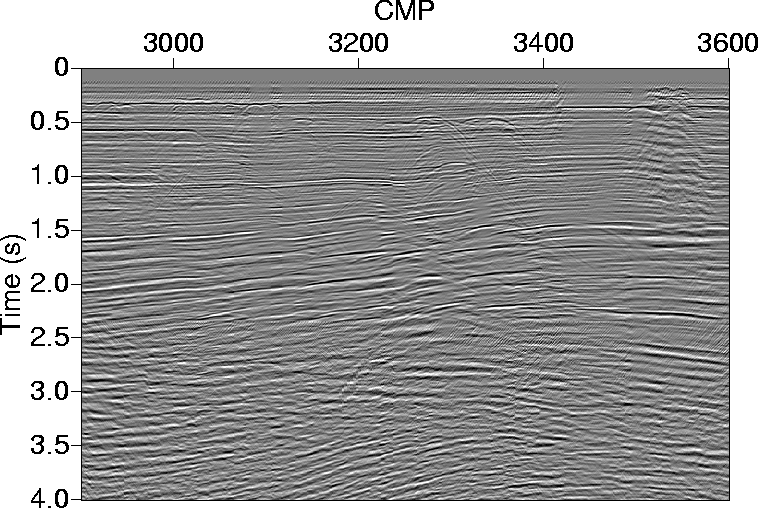
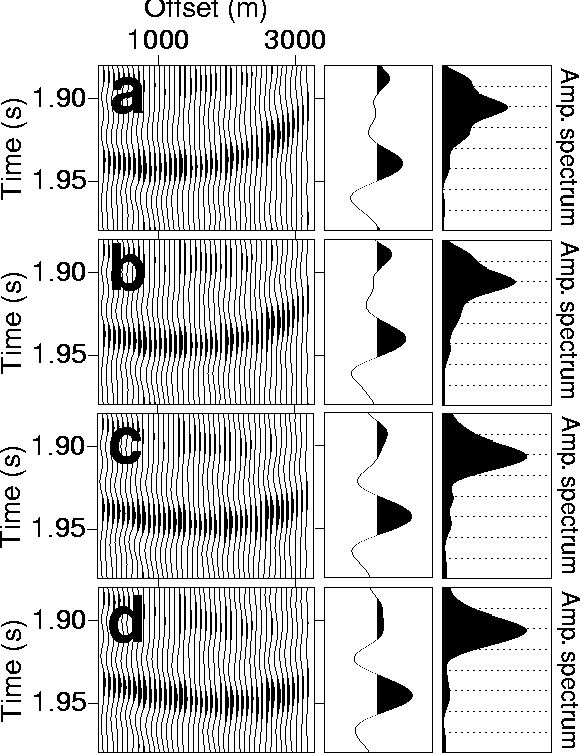
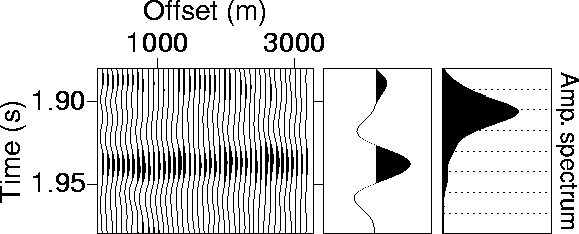

![]() values
extracted
from the non-hyperbolic moveout inversion
for CMP location 3200. Considering that the lateral inhomogeneity is
small, we will use these
values to do VTI DMO and time migration on the whole section (time
processing). The extremely high
values
extracted
from the non-hyperbolic moveout inversion
for CMP location 3200. Considering that the lateral inhomogeneity is
small, we will use these
values to do VTI DMO and time migration on the whole section (time
processing). The extremely high ![]() value
at time 1.5 s is indicative of a highly anisotropic shale layer. Also,
due to the integral relation between the interval values and the
effective ones, the area under
these
value
at time 1.5 s is indicative of a highly anisotropic shale layer. Also,
due to the integral relation between the interval values and the
effective ones, the area under
these ![]() curves, representing the cumulative anisotropy,
tells a better story of the anisotropic impact on the seismic data
than the values for the individual intervals. The presence of a
thick, highly anisotropic shale at relatively shallow depths (i.e., above
zones of interest) will have a serious impact on the effective
anisotropy for all deeper layers. If this shallow anisotropy is not taken into
account in this case, then degradation of the entire stacked
section will result.
Figure 15 shows the result of anisotropic DMO and when
comparing
it with Figure 11 the improvements in focusing the
horizontal, as well
as the dipping reflections, are
obvious.
curves, representing the cumulative anisotropy,
tells a better story of the anisotropic impact on the seismic data
than the values for the individual intervals. The presence of a
thick, highly anisotropic shale at relatively shallow depths (i.e., above
zones of interest) will have a serious impact on the effective
anisotropy for all deeper layers. If this shallow anisotropy is not taken into
account in this case, then degradation of the entire stacked
section will result.
Figure 15 shows the result of anisotropic DMO and when
comparing
it with Figure 11 the improvements in focusing the
horizontal, as well
as the dipping reflections, are
obvious.
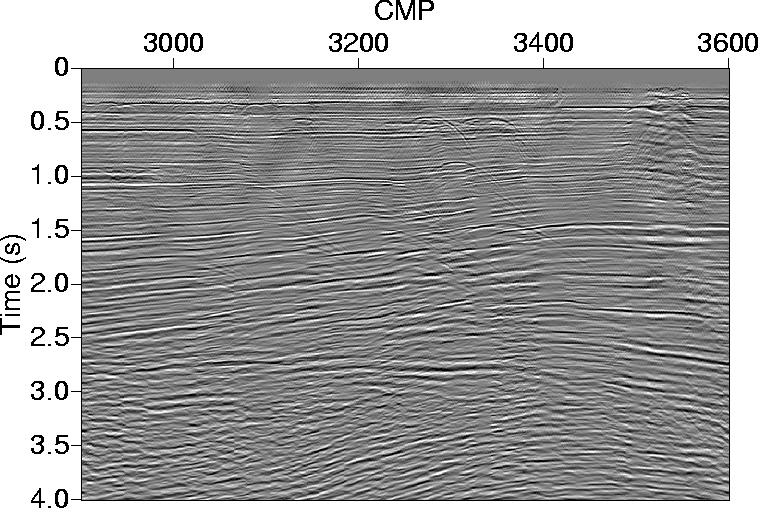
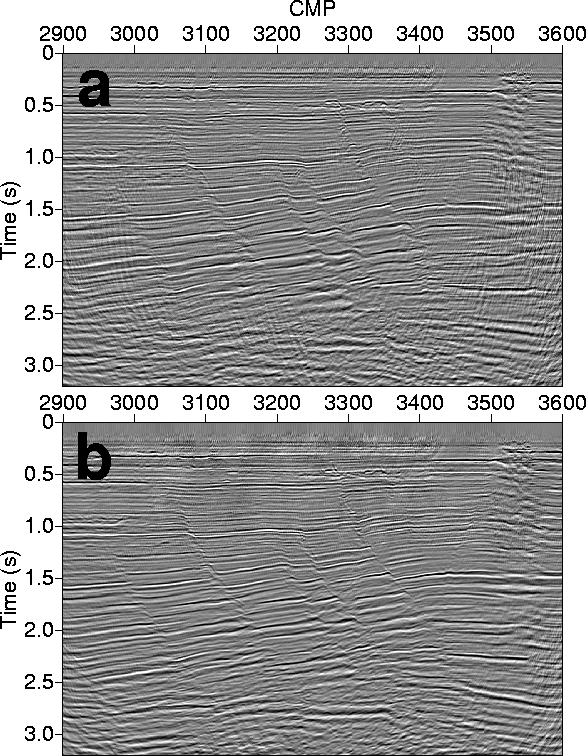
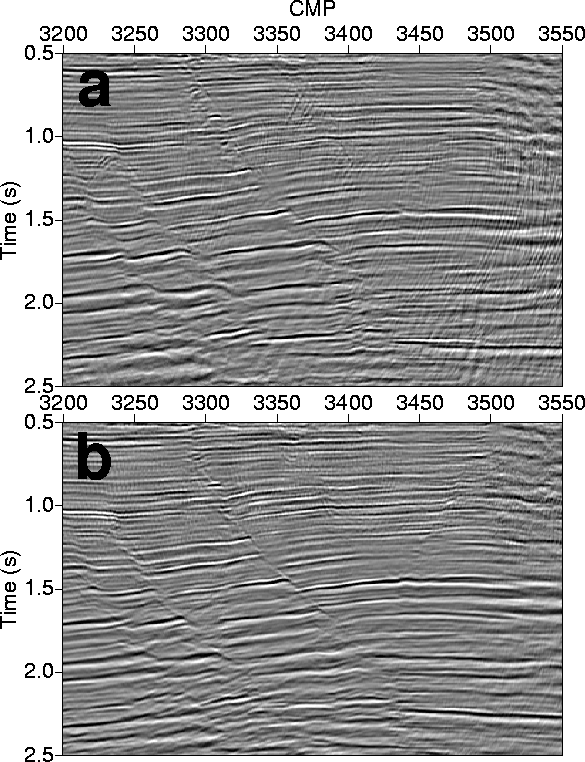
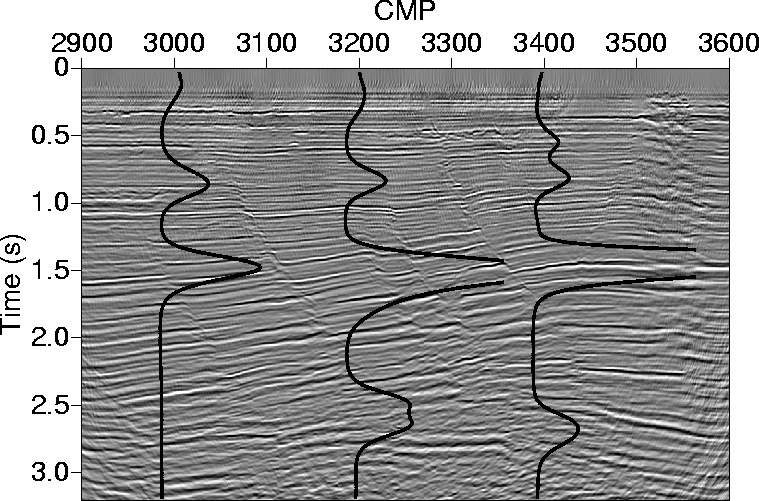
![]() curves superimposed on
the migrated section from Figure 16b. These
curves superimposed on
the migrated section from Figure 16b. These ![]() curves
correspond to CMP locations 3000, 3200, and 3400, and as a result they
are placed in their respective
positions in the Figure 18. Recognizing that the
curves
correspond to CMP locations 3000, 3200, and 3400, and as a result they
are placed in their respective
positions in the Figure 18. Recognizing that the ![]() highs and lows correspond
to reflections from the bottom of the layer
that caused these highs or lows, a crude blocky interpretation of the
curves
can be made and is given in Figure 19. The lateral
correlation between these
curves that are 2.5 km of
lateral distance apart is remarkable. Especially remarkable is the
correlation between the thickness of the shale layers and the size of
highs and lows correspond
to reflections from the bottom of the layer
that caused these highs or lows, a crude blocky interpretation of the
curves
can be made and is given in Figure 19. The lateral
correlation between these
curves that are 2.5 km of
lateral distance apart is remarkable. Especially remarkable is the
correlation between the thickness of the shale layers and the size of ![]() (look at
the first laterally continuous shale layer). The extremely high
(look at
the first laterally continuous shale layer). The extremely high ![]() value
at time 1.5 s is indicative of a highly anisotropic shale layer. While
the actual value may appear unreasonable, CMPs 3200 and 3400 are over
a gas field, while CMP 3000 is outside of the field
(Figure 20). The high
value
at time 1.5 s is indicative of a highly anisotropic shale layer. While
the actual value may appear unreasonable, CMPs 3200 and 3400 are over
a gas field, while CMP 3000 is outside of the field
(Figure 20). The high ![]() values over the field could
suggest vertical migration of the gas into the unconsolidated shale
(this shale is approximately 2000 feet thick at depths of 3000-5000
feet, see Figure 15).
values over the field could
suggest vertical migration of the gas into the unconsolidated shale
(this shale is approximately 2000 feet thick at depths of 3000-5000
feet, see Figure 15).
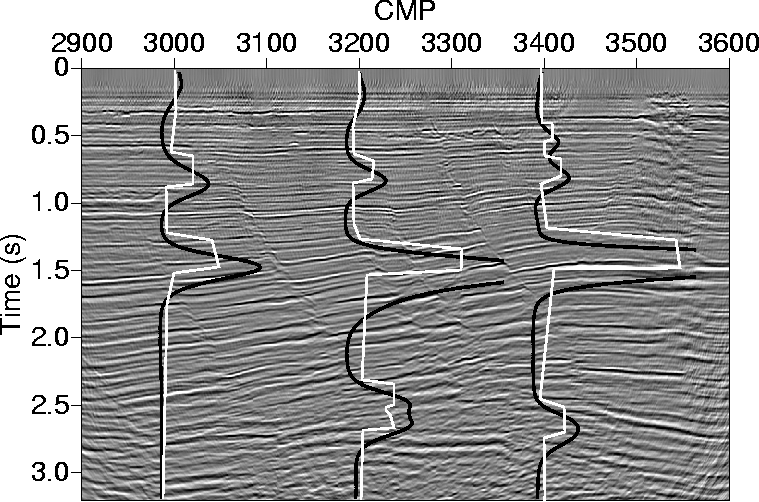
![]() values,
while sands are essentially isotropic with near zero
values of
values,
while sands are essentially isotropic with near zero
values of ![]() . Figure 14 shows the correlation
between the estimate for
. Figure 14 shows the correlation
between the estimate for ![]() at CMP 3200 and a blocky
interpretation of shale volume from the gamma-ray log at a nearby
well. Correlation is remarkably good down to 2.0 seconds,
demonstrating the value of using the inversion for
at CMP 3200 and a blocky
interpretation of shale volume from the gamma-ray log at a nearby
well. Correlation is remarkably good down to 2.0 seconds,
demonstrating the value of using the inversion for ![]() as a
lithology estimator. Correlation is not as good below 2.0 seconds,
though the
as a
lithology estimator. Correlation is not as good below 2.0 seconds,
though the ![]() value shown in Figure 21 shows
a large decrease in velocity below 2.0 seconds indicative of entering
the overpressure zone (which could also impact anisotropy).
value shown in Figure 21 shows
a large decrease in velocity below 2.0 seconds indicative of entering
the overpressure zone (which could also impact anisotropy).

